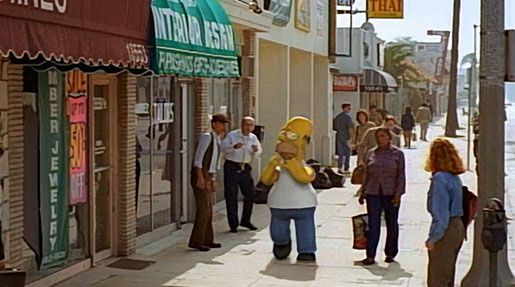
Homer That Never Was. In the April 6-13, 2018 issue of Entertainment Weekly, writer David Cohen and showrunner Bill Oakley remembered some of the other ideas considered for the 1995 episode of The Simpsons Treehouse of Horror VI where Homer goes into a different dimension and is done in CGI (done by Pacific Data Images that produced the segment for free).
Oakley said his original idea was “initially to have the Simpsons’ patriarch to travel through other animation formats but we quickly realized ‘What can we really do besides paper cutouts?’ We could do Claymation but that was a third dimension too. Also it dilutes the conceptual purity of going from second to third dimension. In The Twilight Zone (Little Girl Lost episode that inspired the idea), a little girl goes into the fourth dimension.
“So we said, ‘Let’s dispose of all that other crud…’ We were going to have Homer throttle Bart’s neck. In the second dimension, it wasn’t really hurting him but in this dimension he was going to start screaming, ‘Ow, Dad! Stop it! In here that really hurts for some reason!’”
Writer Cohen shared that originally showing Homer walking down an actual L.A. street was going to be actor Dan Castellaneta, who does Homer’s voice, in a Homer costume but PDI said they could animate Homer in a live action scene. Another pitch would have had actress Julie Kavner, the voice of Marge, as a passerby. Cohen recalled, “Julie was to shudder in revulsion when Homer thought he recognized her.”
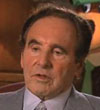 Different Kids. Producer Joe Barbera said in an interview in 1990 for World Features Syndicate: “The Flintstones arrived at a time when there was nothing like it and many of our kids back then are now parents who were raised on it and are buying cassettes. The thing about The Jetsons is that the theme song became a cult song, plus there was something fascinating about the future when we made them.
Different Kids. Producer Joe Barbera said in an interview in 1990 for World Features Syndicate: “The Flintstones arrived at a time when there was nothing like it and many of our kids back then are now parents who were raised on it and are buying cassettes. The thing about The Jetsons is that the theme song became a cult song, plus there was something fascinating about the future when we made them.
“Kids are different today. Television has given them a kind of ear of brightness and smart-alecky quick answers that rubs off. Look at all the shows today: a father, mother, smart-alecky kids. They’re all very glib.”
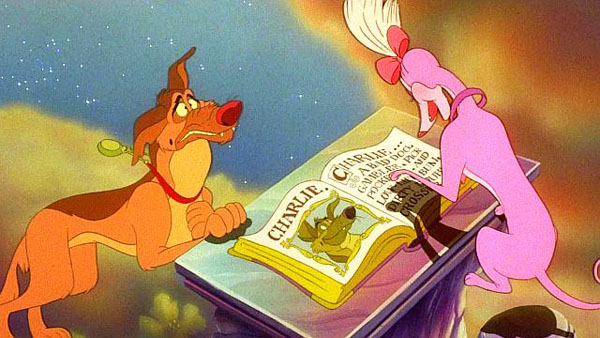
Charlie the Dog. Animator Bob Miller wore the Charlie the dog costume from All Dogs Go to Heaven at the San Diego Comic Con in summer 1990 to help promote at the film at the Don Bluth booth where artists Linda Miller, Lorna Pomeroy-Cook and Cathy Jones were selling sketches as “The She Devils of Animation”.
As Bob marched through the hall, often followed by kids, he passed by the Streamline Pictures booth where both Carl Macek and Jerry Beck in good-natured fun flashed wads of money at him to encourage him to take off the character head. Bob was steadfast and refused to do so. Bob could only see out of the mouth of the character and needed an escort to help guide him.
ACME Forever. Somethin’s Cookin’ is the official name of the animation short film that opens the movie 1988 Who Framed Roger Rabbit (1988). Very few cartoon fans notice all the ACME products: ACME Deadly Mouse Poison, ACME Toastamatic, ACME Powder, an ACME mop, ACME Supacold Refigerator, ACME Suck-O-Lux, ACME Chili Sauce Extra Hot and an ACME Hotternell Range.
No wonder disaster happens. Interestingly the cookies and pickles are generic. The gag at the end is Roger gets yelled at for manifesting birdies instead of stars circling his head. However, the soundtrack is playing Mendelssohn’s Spring Song which would be appropriate for birdies. If they wanted stars, the music should have been Twinkle, Twinkle Little Star.
By the way, the storyboards for that cartoon were drawn by legendary Mark Kausler who also storyboarded the Daffy and Donald sequence. He also animated Droppy, Tweety and some of Benny the Cab in Toontown. Several of his gags got cut including a funeral sequence. A mechanical device for carrying a coffin was actually built for the sequence before it was cut. However, Mark is responsible for the “booby trap” joke that was kept.
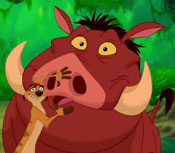 Timon and Pumbaa. In the April 6-13, 2018 issue of Entertainment Weekly, actor Ernie Sabella remembered, “Nathan (Lane) and I were doing Guys and Dolls on Broadway so we went to (The Lion King) audition together. We ad-libbed and had fun with it, came up with our own silly stuff. Two months later, we got the call that you’re Timon and Pumbaa. I was like, ‘Who’s Pumbaa?’ We’d read for the hyenas’.”
Timon and Pumbaa. In the April 6-13, 2018 issue of Entertainment Weekly, actor Ernie Sabella remembered, “Nathan (Lane) and I were doing Guys and Dolls on Broadway so we went to (The Lion King) audition together. We ad-libbed and had fun with it, came up with our own silly stuff. Two months later, we got the call that you’re Timon and Pumbaa. I was like, ‘Who’s Pumbaa?’ We’d read for the hyenas’.”
Producer Don Hahn recalled, “We considered Eddie Murphy for Timon, but Nathan and Ernie brought this great stupid-funny thing to it that worked really well. It’s a heavy story about a lion cub who gets framed for murder so you need this lightness on the side and they were able to provide it.” Before the song Hakuna Matata was introduced, Sabella and Lane recorded one called Warthog Rhapsody.
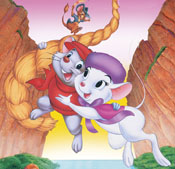 Katzenberg on Animation. From L.A. Weekly April 26-May 2, 1991, Disney executive Jeff Katzenberg defended 1990’s The Rescuers Down Under as being, “in terms of animation, one of the best produced at Disney up there with Pinocchio. It lacked some ingredients that were critically important to other animated successes at Disney – music, some kind of emotional punch.
Katzenberg on Animation. From L.A. Weekly April 26-May 2, 1991, Disney executive Jeff Katzenberg defended 1990’s The Rescuers Down Under as being, “in terms of animation, one of the best produced at Disney up there with Pinocchio. It lacked some ingredients that were critically important to other animated successes at Disney – music, some kind of emotional punch.
“These movies should work on three levels. Our first loyalty is to the kids, the basic core Disney franchise. Next, to ourselves – clearly, it’s not six year olds who are making these movies which have a great sense of wit and humor. Third, and most difficult, they must have an engaging emotional theme. The first Disney movies did not exist in an animation ghetto. They were movies. We want to bring these films back into the center of the universe.”
Frank and Ollie. From the New York Times May 19th, 1996, Jules Engel who was teaching at CalArts said, “Frank Thomas and Ollie Johnston, they fell in love with the medium so desperately that they could hardly wait to get up in the morning and go and do it. They worked at it like dogs because they wanted to. Those guys wouldn’t think of working any other place that could make them more money. For them, it was the art of it, and the falling in love with it.”



 Jim Korkis is an internationally respected animation historian who in recent years has devoted his attention to the many worlds of Disney. He was a columnist for a variety of animation magazines. With his former writing partner, John Cawley, he authored several animation related books including The Encyclopedia of Cartoon Superstars, How to Create Animation, Cartoon Confidential and Get Animated’s Animation Art Buyer’s Guide. He taught animation classes at the Disney Institute in Florida as well as instructing classes on acting and animation history for Disney Feature Animation: Florida.
Jim Korkis is an internationally respected animation historian who in recent years has devoted his attention to the many worlds of Disney. He was a columnist for a variety of animation magazines. With his former writing partner, John Cawley, he authored several animation related books including The Encyclopedia of Cartoon Superstars, How to Create Animation, Cartoon Confidential and Get Animated’s Animation Art Buyer’s Guide. He taught animation classes at the Disney Institute in Florida as well as instructing classes on acting and animation history for Disney Feature Animation: Florida.




















































You know, I loved the idea of “WHO FRAMED ROGER RABBIT” and its homage to the golden era of theatrical animation, but the one thing that it got so terribly wrong is the orchestration! If you listen to most cartoons of the golden age, the one thing that truly makes them golden, besides the skilled and detailed animation itself, is the equally detailed and careful orchestration. I don’t know if the individual musicians in any given studio orchestra were given this sort of instruction, but it was as if they were all told that, as they work at arranging the proper scoring for a cartoon, each one of them are the characters to which music is being added to emphasize who they are and how they moved. You just don’t find that in almost all new animated film.
The orchestra, if there is one, seems to play as if they are still in a concert hall playing to audiences waiting to hear a classical piece. *NO*! The score is (or should be) always there to add dimension to the visuals you are seeing onscreen, and I don’t get that as I rewatch the Maroon Cartoon embedded here. The sound effects are good, but I think of how both the sound effects and orchestra of, say, a classic Warner Brothers cartoon actually added to the comedy as it unfolded. Even before Carl Stalling came into the picture at Warner Brothers, you could hear little bits of scoring that told you who the hero was and who the villain was, and believe me, you had to be equally skilled to so perfectly embody each character like that.
Look at how Stalling enhanced certain aspects of classical music, not only in cartoons like “CORNY CONCERTO” where classical music and animation coming together were lampooned, but in cartoons where animation and actual classical composition came together in a similar way as in Walt Disney’s “FANTASIA”, like the INKI cartoons which used the classical piece, with augmentation, to identify the mysterious little bird who just shows up to halt the action while it hops through a scene. If “WHO FRAMED ROGER RABBIT” was really paying homage to a bygone era, it should have done so right down to the proper scoring.
Personally, I love Alan Silvestri’s score for “Something’s Cookin’” and the rest of the movie, it’s one of my all-time favorite movie music. But you do make an important point; the score for most classic cartoons was conceived alongside the action, not added after as is the norm in live-action. Carl Stalling composed his scores based on the directors’ bar sheets before a single frame of animation was drawn. At Disney the director’s room was also known as the Music Room because the composer worked alongside the director in timing out each cartoon. Sadly, this approach is largely forgotten, especially in feature films.
The amount of detail and the number of Golden Age cartoon references in the animation of Who Framed Roger Rabbit is absolutely astounding, it’s like a love letter to Golden Age cartoons.
Also nice to see Frank Thomas and Ollie Johnston reportedly be so passionate about animation. But when it comes to them and the other seven Old Men and establising the “Disney style,” despite being great artists would others have perhaps created a less stereotyped style?
From Michael Barrier: http://michaelbarrier.com/Commentary/Williams_and_Canemaker/Williams_Canemaker.htm
But did it, really? Consider the roughly thirteen years between the release of Steamboat Willie in 1928 and the release of Dumbo in 1941—years when almost all the Disney films were dominated not by any of the “nine old men,” but by an earlier generation of character animators that included Ham Luske, Norm Ferguson, Fred Moore, Art Babbitt, and Bill Tytla. The advances made in those years are simply astonishing. To watch the Disney shorts of the thirties in roughly chronological order is to see a wonderful medium being born, as the crude, puppet-like characters of the earliest cartoons give way to thinking, feeling creatures of tremendous vitality.
…
Compared with the trajectory of Disney animation in the thirties, what came later was a steady decline, bottoming out in the dismal features made in the years just after Walt Disney died. If the “nine old men” cannot be blamed for that decline, most of them did little or nothing to arrest it, and Reitherman certainly accelerated it.
First of all, I think you are over analyzing things with Barrier’s rather controversial opinions (this is from a guy that hates “Mary Poppins” and overly bashed the flaws of the Porky DVD set).
Second of all, it was my like the “Six Old Men” by the time of Walt’s death as Davis, Clark (who I think should’ve be put in charge of the animated features), and Kimball were working at different department of the studio.
Well, Barrier was right about that particular movie, and his biography of Walt Disney is the most objective I’ve ever read, and I’ve read plenty. Even that potboiler trash by Marc Eliot relied on lie after lie but still toed the company line in its attempt at a critical assessment of his work. It was like reading video box quotes interspersed with sub-Kitty Kelley-level innuendo. Barrier paints a much more complex picture of Walt that neither dismisses his accomplishments outright nor acted like his shit didn’t stink.
God, how I wish the funeral sequence hadn’t been cut from “Who Framed Roger Rabbit”. So many excellent gags (the best, actually, IMO) and cameos lost.
Rescuers Down Under becomes depressing when you realize the poor poached critters aren’t freed from their imprisonment and promptly forgotten by the heroes, and presumably left to perish.
That’s interesting about RESCUERS DOWN UNDER. I was really impressed by its adult quality; in fact, when I went to see it, there was a father there with his little boy. The kid was bored and wanted to leave, but Dad kept saying, “No, no, let’s stay and see how it turns out.” I imagine that was a big lesson learned for Disney.